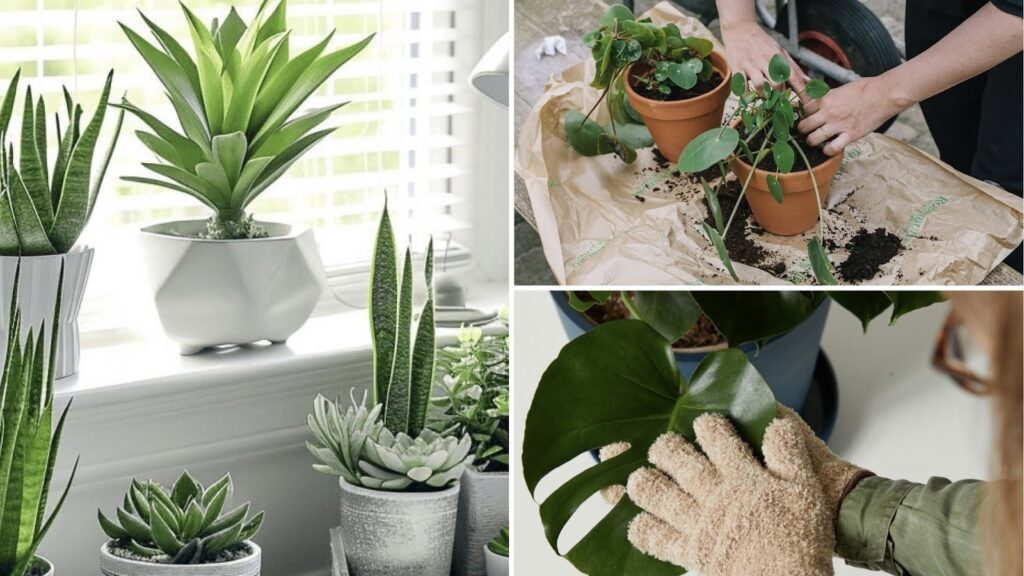Small indoor plants are more than just decorative elements; they breathe life into our spaces, offering a fresh, natural touch. Are you a seasoned plant enthusiast or maybe a beginner? Then you should know that adding plants to your home creates a soothing environment.
Source: Pinterest
The good news is that caring for these small indoor plants doesn’t have to be difficult, even for a novice. Let’s explore some essential tips to help you keep your indoor plants thriving.
1. Choosing the Right Small Indoor Plants
The first step in caring for small indoor plants is choosing the right one for your home. Some plants are more suited to indoor living than others. Common houseplants like succulents, spider plants, and peace lilies are excellent for beginners.
Source: Pinterest
These low-maintenance plants require little care and can thrive even in challenging indoor conditions. If you’re just starting out, look for plants that are easy to grow and match the conditions of your home.
2. Finding the Right Water Balance
Knowing how much water your plants need is key. Some small indoor plants require more frequent watering, while others, like succulents, prefer dry conditions. The trick is to find a balance—overwatering can lead to root rot, while underwatering can cause wilting.
Source: Pinterest
Always check the soil moisture before watering. A good rule of thumb is to let the top inch of soil dry out before adding more water. This simple habit will keep your plants healthy and happy.
3. How to Care for Low-Light Plants
If your home doesn’t have a lot of natural light, don’t worry. There are plenty of low-light plants that can survive and thrive without direct sunlight. Plants like pothos, snake plants, and ZZ plants are fantastic options.
Source: Pinterest
These plants can adapt to darker environments, making them ideal for rooms with minimal sunlight or even office spaces. Understanding which small house plants can handle lower light conditions is crucial to keeping them healthy.
4. Fertilizing Your Small House Plant
Just like outdoor plants, your small houseplant will benefit from occasional feeding. Using a balanced liquid fertilizer every few weeks during the growing season (spring and summer) helps them get the needed nutrients.
Source: Pinterest
Fertilizing is especially important if your plant seems to be struggling or has been in the same pot for a long time. Don’t overdo it though—too much fertilizer can harm your plant more than it helps.
5. Repotting: When and How to Do It
As your small indoor plants grow, they’ll eventually need to be repotted to allow more room for their roots. Repotting helps the plant stay healthy by giving it fresh soil and more space.
Source: Pinterest
Look for signs like roots growing out of the drainage holes or the plant becoming too large for its pot. Repotting is best done during the growing season to minimize stress on the plant.
6. Handling Low-Light Conditions
If you have a plant without good lighting conditions, try moving it closer to a window or supplementing it with artificial light. LED grow lights are great for low-light plants that need a little extra help.
Source: Pinterest
Placing plants in areas with indirect sunlight or using lamps can also make a big difference. Remember, some plants naturally prefer less light, but others may need this little boost to stay strong and healthy.
7. Dusting and Cleaning Common Houseplants
Keeping your common houseplants dust-free is a simple but often overlooked part of plant care. Dust buildup on the leaves can block sunlight and make it harder for plants to breathe.
Source: Pinterest
As often as you can, gently wipe the leaves with a damp cloth every few weeks to keep them clean. Not only does this improve the plant’s health, but it also makes your indoor greenery look fresher and more vibrant.
8. Trimming and Pruning for Better Growth
Pruning isn’t just for outdoor gardens—your small indoor plants will also benefit from the occasional trim. Regular pruning helps to remove dead or yellowing leaves, which can attract pests and stunt the plant’s growth.
Source: Pinterest
Trim back overgrown branches to encourage new growth and shape the plant. This is particularly important for plants like spider plants, which can grow quickly and become unruly.
9. Common Issues with Small Indoor Plants
Even with the best care, your small indoor plants might face a few challenges. Common problems include yellowing leaves, drooping, or pests like spider mites.
Source: Pinterest
To combat these issues, keep an eye on your plants and act quickly if something seems off. Whether it’s adjusting watering habits or treating a pest problem, prompt care can prevent bigger issues down the road.
10. Enjoy the Benefits of Indoor Plants Year-Round
Caring for small indoor plants can be a relaxing and rewarding hobby. Not only do they beautify your space, but they also improve air quality and create a more peaceful atmosphere.
Source: Pinterest
By following our tips, even a beginner can keep their indoor plants thriving. So go ahead—add some green to your home and enjoy the many benefits these little plants bring.
Wrapping Up
There’s no better time to refresh your living space with the beauty of small indoor plants than now. Whether you’re a novice or not, these common house plants will help you create a cozy, natural environment.
Source: Pinterest
With the right care and attention, your plants will flourish. They will also give you a sense of accomplishment as you watch them grow.
